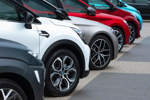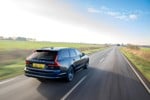This week: 30-11
OUR search for the ultimate company car of all time continues this week as we spotlight numbers 30-11.
We asked dozens of top figures from the fleet and leasing industries for their opinions on the cars they have driven, bought and sold over four decades of company motoring.
Their choices are not based on sales, or profit or price. It’s purely personal opinion of their favourites based on years of experience.
We haven’t included cars that have been on sale for less than two years – they haven’t completed an entire contract cycle so have yet to establish their places in the pantheon of greats.
Last week we announced those from 50 to 31, and here we count down from 30 to 11. Next week, we’ll count down to the car they voted as ‘The Greatest Company Car Ever!’
30. VAUXHALL VECTRA

Following the popular Cavalier, the Vectra had its work cut out and it didn’t do a great job. It didn’t handle very well and managed to come last in the JD Power survey of 2001. But it still proved its worth as a fleet car, selling almost 70,000 a year from 1996-98, mainly thanks to Vauxhall’s heavy support for it and strong relationships with fleet customers.
29. BMW 5-SERIES

The new 5-series had a hard act to follow when it was launched in 2003 and its ‘flame surface’ design certainly sparked controversy. But nearly three years on, it is now a staple of the executive car park with excellent engines, healthy residuals and even a decent standard of specification. iDrive is still infernal, though.
28. ROVER SD1
A replacement for the Triumph 2000 and Rover P6, the SD1 was a popular car, mainly thanks to British Leyland’s shameless plundering of the Ferrari Daytona’s lines. It also won the 1977 European Car of the Year award. Originally with 2.3, 2.6 and 3.5-litre engines, after a facelift in 1982 it also came with a more proletarian 2.0-litre unit.
27. PEUGEOT 205

It seems strange to think that before the 205, Peugeot was seen as a big car builder. The 205 was an instant hit, but the real jewel for company car drivers was the 130bhp 1.9 GTi. It went like stink, handled like a go-kart, looked great and came in under the old 2.0-litre benefit-in-kind tax threshold. A winner on all counts.
26. VAUXHALL ZAFIRA

It may not have been the first mini-MPV but the Zafira certainly led the way when it came to practicality. With its Flex7 seating, it could reasonably take seven adults in comfort, while its interior was suitably workmanlike to allow for all those little family disasters.
25. VAUXHALL CARLTON

In many ways the Carlton was the spiritual predecessor to the BMW 5-series, offering fantastic rear-drive handling in a value-for-money package, especially in GSi 3000 form. It was much better to drive than a Granada and, in the 175mph Lotus Carlton, legendary. Ultimately, the Carlton was killed off by the march of the premium brands.
24. AUSTIN MAXI
The Maxi might seem oddly lofty in our list, but it set a template for company cars still going strong today: it had five doors, making it the first genuine fleet hatchback. The Maxi may have had the dynamism of a garden shed but with front-wheel drive, a spacious interior and cheap prices, it set the mould that the Focus, Astra, Golf et al have followed.
23. RENAULT ESPACE

The third generation Renault had a radical, futuristic dashboard and a plastic body made by Matra. Generally credited with introducing the MPV to Europe, Renault has always punched above its brand weight with the Espace. This model, with early common rail diesel engines, was handsome, well-equipped and practical.
22. CITROEN DS
The DS is fondly remembered for its Gallic flair and groundbreaking technology like hydraulic suspension, power steering, semi-automatic gearboxes and directional lights. Unfortunately these innovations didn’t always work very well. Not a volume repmobile, but the DS was still a company car loved by fashionisti such as architects and designers.
21. CITROEN XSARA PICASSO

The Picasso proved that mini-MPVs could be popular with fleets. Thanks to its cheap front-end price and low running costs, along with handy storage and flexible cabin, it was among those which led the charge away from the ubiquitous upper-medium saloons and hatchbacks into niche vehicles. A great Motability car.
20. HONDA ACCORD

Honda’s latest Accord has transformed the brand from solid and dull into something much sexier and classier. Ultra-reliable, well-equipped and stylish, with a star in the 2.2 diesel engine, Honda is pitching the car at the premium end of the market and making some gains. The Tourer may look suitable as a hearse but it is vast.
19. JAGUAR XJ

Until the S-class arrived in 1991, the Series 3 XJ was the car that said you had made it. Available as either XJ6 or XJ12 from 1979, this car almost single-handedly kept Jaguar afloat during the dark days of the 1980s and, while it had its share of reliability issues, still hit the spot for thousands of British executives.
18. VOLKSWAGEN GOLF

The Mark 3 Golf might have got a bit lardy and lost a little of the snap of previous models but it was still a much-loved company car because it managed to appeal right across the board. Employees at many levels could find a model to suit their station and for many the 2.0 GTi – irrespective of its sporting shortcomings – was it.
17. FORD CORTINA

The first in a long line of legends, the Mark I Cortina copied the style of American saloons of the time, with its sharky tail fins and bulging headlights. But it was British and a staple of company car drivers of the late sixties. Standard versions came with 1.2 and 1.5-litre engines, but who can forget the tuned white-and-green Lotus Cortina?
16. VAUXHALL ASTRA
The Astra that, along with the Focus, powered the rise of the lower- medium sector as the force in fleet. It might not have been very exciting but there was something for everyone with this Astra, from standard three and five-door hatches, estate, saloon, a Bertone- designed convertible and coupe – and even LPG-powered versions.
15. FORD GRANADA
The Mark II Granada followed the square-edged, beautifully proportioned style of the Cortina of the same age and proved a hit in the company car park among executives as a result, especially in 2.8-litre Ghia and Ghia X specifications, equipped with luxuries such as air conditioning.
14. BMW 5-SERIES

That the 5-series was still reckoned to be the best car in its class at run-out illustrates just how good it was. Whether it was a bog standard 2.5-litre diesel with no kit or an M5, the ultimate businessman’s express, the 5-series rarely put a foot wrong, Great residuals, handsome design and a driver’s car as well – the best executive car ever built.
13. FORD ESCORT

The first front-wheel drive, independently sprung and hatchback Escort, the Mark III was intended to pitch into battle against the Golf and especially the GTi, with the launch of the XR3 brand. The Escort soon became the ubiquitous junior company car, with convertible, three and five-door estates, RS1600i and RS Turbo versions.
12. PEUGEOT 405

The stylish Pininfarina-designed 405 broke Peugeot into the fleet market in a big way. Voted European Car of the Year in 1988, the 405 came in saloon and estate versions, and proved, years ahead of many of its competitors, that with its 1.9-litre diesel, the future of company car driving was DERV-powered.
11. FORD FOCUS

A shock result – the mighty Focus doesn’t make the top 10, with slow-to-market common rail diesel engines and residuals the main reasons. Radical when it came out but with mass market appeal, the Focus was a great driver’s car and, although the dash was a mess, it brought new levels of interior quality to the volume sector.
WHAT’S YOUR FAVOURITE?
Which company car is YOUR number one? We’ll be featuring reminiscences from our readers in Fleet News. Email: fleetnews@emap.com















Login to comment
Comments
No comments have been made yet.